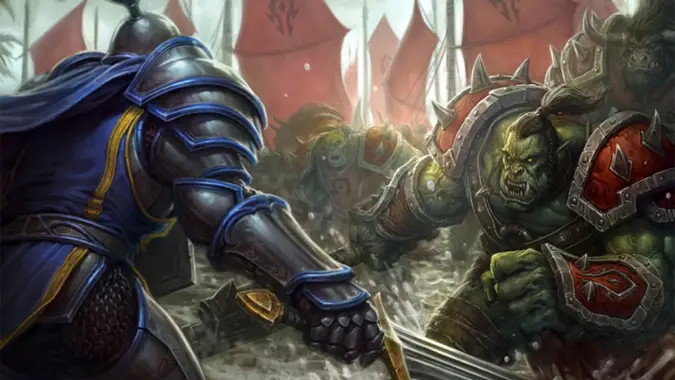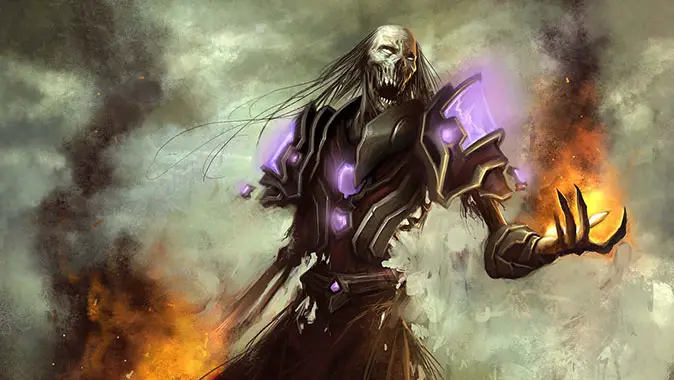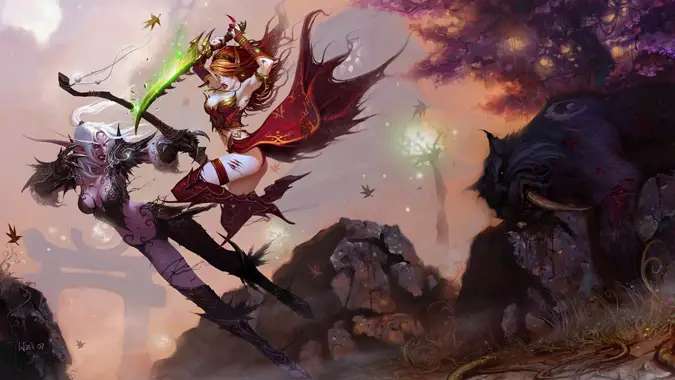Role Play: Choosing a faction — Horde

Last week, we discussed the basics of the Alliance faction — which races are available to play, and the kind of plot points you can expect to see with each race. The Alliance are often touted as the “good guys” of the Warcraft universe, the golden heroes who are always pitted against the forces of evil, no matter what that evil might be. If there’s something threatening the world, the Alliance are the ones who are always going to be mounting some kind of assault to prevent it.
The Horde of Warcraft are in comparison usually presented as the “bad guys” of Azeroth. This is generally because the Alliance and Horde are constantly locked in one kind of confrontation or another — albeit most of the time, that’s in PVP situations. While some Horde races are definitely skirting the line of full-on villainy, there are plenty of Horde races that…aren’t. Let’s take a closer look at what it means to be Horde, should you choose to roleplay a Horde character.

The Horde
The main reason the Horde is by and large considered the “bad guy” faction is pretty simple: Back in the early days of the Warcraft RTS games, they absolutely were. The original Horde were the Orcs of Draenor, who were corrupted by the Burning Legion and subsequently invaded Azeroth with the intent of conquering it…and slaying anyone who happened to be standing in their way. In fact, this original Horde is the reason the Alliance came to be — the Alliance of Lordaeron, predecessor to the Alliance of today, was created to counter the old Horde during the Second War.
The new Horde — the Horde of today — was created after the old Horde was defeated after the Second War. Thrall broke the Orcs free from the internment camps in which they’d been imprisoned, and became leader of the new Horde. But there’s a difference between the Horde of old and today’s Horde: While the old Horde was comprised completely of Orc clans who had been corrupted by the Burning Legion, today’s Horde is instead a collection of various races, brought together for one purpose — survival.
However, that doesn’t mean that old hatreds died out. The Alliance is not happy with the Horde’s existence, and although Thrall and Lady Jaina Proudmoore tried to reach some kind of diplomatic peace between the two factions, that peace was never achieved. Couple that with the rise of Garrosh Hellscream as Warchief — and his deliberate attacks on Alliance settlements, including the destruction of Theramore — and the Alliance has every bit of proof they ever needed to paint the Horde as “bad guys.”
But are they really bad at heart? It could be argued either way. If you’re looking to play a faction in which existence itself is a struggle you have to deal with, the Horde is probably for you.

Horde races
Just like the Alliance, the Horde has seven races to choose from:
- Orcs: Orcs have long been viewed as the “leaders” of the Horde,simply because Thrall was the first Warchief, and it was his actions that brought other races into the Horde to begin with. But after the disastrous reign of Warchief Garrosh Hellscream, tensions between Orcs and the other races of the Horde have been…strained, to say the least. There are Orcs who were loyal to Garrosh and his ideals of a conquered world with the Orcs sitting firmly on top of it all. And there are Orcs who believed in the ideals Thrall represented — diplomatic ideals of a peaceful world. No matter which type of Orc you choose to play, you’re apt to have an interesting time, because even in the other races of the Horde, there are those that aren’t necessarily sure they can trust an Orc just yet.
- Trolls: Trolls are in an unusual position in the Horde. As a Horde Troll, it’s likely you’re a member of the Darkspear — a small tribe that was originally pushed out of the Gurubashi Empire in Stranglethorn Vale. Since then, the tribe has been remarkably self-reliant, and joined the Horde as a result of Thrall’s actions on the original Darkspear Islands. He saved the Darkspear from certain disaster, and Vol’jin swore the Darkspear’s loyalty to Thrall and the Horde in gratitude. However, Vol’jin most definitely did not agree with Garrosh Hellscream’s idea of what the Horde should be. He led a rebellion against the former Warchief, and now Vol’jin is the new Warchief of the Horde. Troll Druids in particular may have some interesting things to look forward to in Legion, particularly since there are some Druid-heavy storylines in upcoming content.
- Tauren: Tauren are also in an unusual position — far from anything that could be considered villains, the Tauren are by and large peaceful, with few exceptions. But they recently went through a series of upheavals. The original leader of the Tauren, Cairne Bloodhoof, was killed in a duel to the death with Garrosh Hellscream…and he was killed due to interference from a Tauren, Magatha Grimtotem, who poisoned Garrosh’s blade without his knowledge. After Cairne was killed, Magatha led the Grimtotem in an attempted coup. She was subsequently defeated by Cairne’s son, Baine, who holds many of the peaceful ideals of his father. Baine didn’t agree with Garrosh Hellscream’s actions either, and he threw his support — and the support of the Tauren — in with Vol’jin’s rebels. As with the Trolls, Tauren Druids should have some interesting things to look at in the upcoming expansion.

- Forsaken: The Forsaken are arguably the most villainous creatures to exist in the Horde. Former citizens of Lordaeron who lost their lives in the Third War, the Forsaken were once part of the Lich King’s undead Scourge. After regaining their memories and their free will, these walking dead realized they had no future before them…until Sylvanas Windrunner stepped in, took them by the hand, and led them down the merry path of vengeance. The Forsaken underwent a coup of their own during Wrath of the Lich King, when the Undercity was nearly claimed by a supposed rogue faction. Once dealt with, Sylvanas and her kind were placed under the watchful eyes of the Kor’kron, and pitted against the Worgen of Gilneas. Now that Garrosh Hellscream is out of the picture, Sylvanas and her people are free to do whatever they like…and knowing the Forsaken, there’s likely some kind of plague involved. The Forsaken have a much heavier role in the upcoming expansion, so Forsaken players should have plenty to work with.
- Blood Elves: The Blood Elves were actually once members of that original Alliance of Lordaeron back in the day — they were called High Elves at the time. But after the Second War was over, they withdrew — and when the Scourge razed Quel’thalas during the Third War, they received nothing but scorn from the Alliance that once supported them. Left with no Sunwell and no options, the Blood Elves joined up with the Horde. The Blood Elves’ relationship with the Horde isn’t exactly strong — Garrosh Hellscream treated them with little kindness during his reign. At one point, the Blood Elves even considered deserting the Horde and re-joining the Alliance. Unfortunately, too much damage had been done on both sides, and instead of deserting, the Blood Elves joined the rebellion against Garrosh. There is a lot of Night Elf lore in Legion — and it all involves that ancient civilization that existed before the High Elves were exiled from Kalimdor. All this ancient magic and lore may be very interesting to Blood Elf characters.
- Goblins: Goblins are an interesting addition, because they don’t exactly have a ton of background. The Goblins of the Horde came from the Bilgewater Cartel, forced to desert their home when Deathwing arrived in Cataclysm. Much of the Goblin backstory can be found while playing through the starting zone. However, Goblins as a whole are generally a neutral presence in Warcraft — the Bilgewater Cartel is an exception. Goblins aren’t really concerned with politics so much as making a profit…but Garrosh Hellscream took advantage of their technological prowess, rescinded payment for work done during his rule as Warchief, and generally treated the Goblins like scum. This didn’t sit well, and the Goblins joined the rebellion against Garrosh.
- Pandaren: The Pandaren of the Horde are just like the Pandaren of the Alliance — they’re looking to learn more about Horde culture. They certainly got an eyeful of that culture during the Siege of Orgrimmar, and saw the faction at its worst: divided and tearing itself apart from within. Pandaren weren’t exactly treated kindly by Garrosh Hellscream, and while many have since stuck with the Horde, that lost trust may still leave bitter feelings among Pandaren characters. As we went over last week, Pandaria originally separated from the continent of Kalimdor and was cloaked away in mists because of the impending arrival of the Burning Legion back during the War of the Ancients — so the Broken Isles and the Legion are both threats they can understand.
Moving forward
It is remarkably easy for a Horde character to fall into that villain role, simply because common perception paints so many of the Horde races as potential villains to begin with. We’ve spent time fighting terrible Orcs, dozens of different Troll tribes, undead by the thousands, Goblins that have gone down the wrong road, Blood Elves obsessed with magic to the point where they’ve lost all sense of reason, and even Tauren tribes that aren’t allied with the Horde at all. In fact, pretty much every Horde race has a villainous side that’s been pitted against both Alliance and Horde in equal measure.
And the Horde isn’t without guilt in the least. The Forsaken willingly and happily unleashed the plague on Gilneas without a second thought. Garrosh Hellscream launched an all-out assault on Theramore that ended in the city’s destruction — and also ended any hope the Horde might have had for diplomacy. But not everyone in the Horde is automatically a villain, and you definitely do not need to feel obligated to play a Horde character as a villain at all.
For Horde characters, a lot of the conflict they encounter is simply the side-product of trying to survive in a world that doesn’t want them around. And in recent years, it seemed as though the Horde was simply going to tear itself apart. A Horde hero is an interesting role to play, because you’re not just looking at saving the world from whatever dark forces happen to threaten it — it’s possible your character is also looking for a little redemption, a little forgiveness, or a little absolution at the same time. They can be bitter and weary, resigned to the circumstances that brought them to where they are today — or they can strive to reach beyond it.
Next week, we’ll take a look at solving the peculiar puzzle of inter-faction roleplay, and what happens when these two factions try to work together.
Please consider supporting our Patreon!
Join the Discussion
Blizzard Watch is a safe space for all readers. By leaving comments on this site you agree to follow our commenting and community guidelines.
 @Shadesogrey
@Shadesogrey



